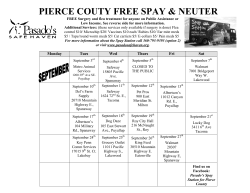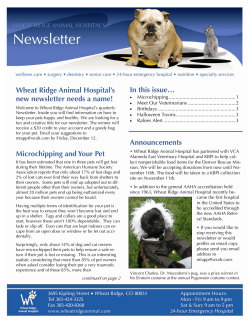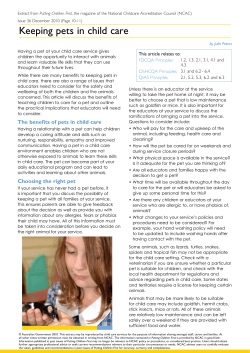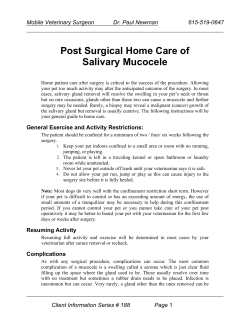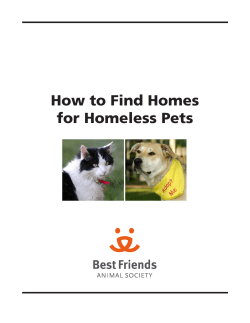
How to Find Homes for Homeless Pets
How to Find Homes for Homeless Pets About Best Friends Animal Society Best Friends Animal Society is working with you – and with humane groups all across the country – to bring about a time when there are no more homeless pets. The sanctuary at Angel Canyon, in the Golden Circle of southern Utah, is home, on any given day, to about 1,500 dogs, cats, and other animals from all over the country. Many of them need just a few weeks of special care before they’re ready to go to good new homes. Others, who are older and sicker, or who have suffered extra trauma, find a home and a haven here, and are given loving care for the rest of their lives. In our home state, Best Friends manages a model No More Homeless Pets campaign with shelters and humane groups, to ensure that every healthy companion animal that’s ever born can be guaranteed a caring home. And Best Friends reaches across the nation, helping humane groups, individual people, and entire communities to set up spay/neuter, shelter, foster, and adoption programs in their own neighborhoods, cities, and states. The work of Best Friends is supported entirely through the donations of our members. Through the generous hearts and hands of people like you, we’re getting close to the day when there will be No More Homeless Pets. Thank you for being part of this work of love. Best Friends Animal Society 5001 Angel Canyon Road Kanab, UT 84741 Phone: (435) 644-2001 E-mail: info@bestfriends.org Website: www.bestfriends.org How to Find Homes for Homeless Pets 3 Introduction Has something happened in your life and you can no longer take care of your pet? Or perhaps you have found a stray cat or dog and need to find him/her a home. Maybe a friend or relative has died, leaving one or more pets to be placed in a new home. You want to be able to do something to help find a new and loving permanent home, rather than turning the pet over to the local shelter or humane society, where the animal may be put down. Table of Contents What to do when you’ve found a stray ...............4 How to get the word out ......................................5 How to prepare the pet for adoption ...................7 How to screen potential adopters ........................8 Interviewing the potential adopter ......................8 Meeting the potential adopter ...........................11 Finalizing the adoption .....................................12 Some final words...............................................12 Appendix ...........................................................13 Something to consider… If you, or someone you know, is considering giving up a pet because of a behavior problem or other issue that you’d like to discuss, you may want to contact us. A trained Best Friends Network coordinator may be able to offer advice or assistance that will enable you to work things out so that you can keep your pet. You can talk to a Network coordinator by calling (435) 644-2001, ext. 123, or sending an e-mail to bfnetwork@bestfriends.org. Best Friends Animal Society We hope the suggestions in this booklet will help you achieve your goal. First, we’ll talk about what to do if you’ve found a stray. (If you locate the pet’s owner, you may not even need to find a new home!) If you do need to find a new home for the pet, we’ll show you how to get the word out. We’ll talk about how to create an effective flyer, how to take a good photograph of the pet, and how to write imaginative text (to capture the attention of a prospective adopter) for a flyer or a classified ad in the newspaper. And we will show you how to take advantage of the networks already established to advertise your animal. We then discuss the preparation of the pet: making sure that the animal’s vaccinations are up-to-date and that he/she is healthy, bathed and groomed. We also walk you through the very important screening process. (We assume you don’t want to just give the pet away without making sure that he/she is going to a good, responsible home.) We suggest questions to ask to find out if the prospective adopter will provide a suitable home. We provide information on how to finalize the adoption. In the appendix, you’ll find examples of an adoption contract, a medical record, and an adoption screener’s worksheet. Finally, we offer some words of encouragement in your quest to find a good new home. www.bestfriends.org How to Find Homes for Homeless Pets 4 What to Do When You’ve Found a Stray 1. Check for a tag or microchip. If you’ve found a stray, do the obvious first – check for a tag! If there is a tag, and the owner’s name is on it, call and arrange for a pickup, and know you have done your good deed for the day. If the tag gives the name of a veterinarian’s clinic, call during business hours and get the name and phone number of the owner using the code number on the tag. Then follow up to return the dog or cat. If the animal has no tag, there may still be a way to identify the stray if he/she has been microchipped. A veterinarian can help you find out. If there’s no tag or microchip, put a temporary tag on the animal with your name and phone number. You can use a luggage label or even tape the information around the collar with some duct tape. 2. Notify your local shelter that you have found a stray animal. There are different laws in each city regarding stray animals. In some communities, finders of lost animals are legally required to either surrender the animal to the animal shelter or to report to the shelter that they have a stray animal. Check with your local animal control or animal services department in your city to find out what your legal obligations are. Even if you’re not legally required to notify the shelter, you’ll still want to let them know that you have a stray. If the owners of the animal are looking for their pet, they will most likely start by calling the shelter, so it’s very important that the shelter knows that you have found the pet. Also, some shelters have bulletin boards on which people can list lost and found pets, so it’s a good idea to post a photo of the pet at the shelter. If you have some hesitation about trying to find the owner, keep in mind that just because an animal is injured, scared, or without identification does not Best Friends Animal Society mean that he had a “bad” home. Your stray might have lost his identification; he might have been lost for a long time; he may even be a rescued animal who was scared when he was adopted. If you must take the animal to the shelter, and you wish to do everything you can for the animal, be sure to claim last rights. Last rights give you adoption privileges if the animal is not claimed within a given time period and is due to be put down. It is a good idea to call the shelter daily to let the staff know that you are interested in the animal’s welfare. 3. Make every effort to find the owner. Besides notifying your local shelter, you’ll want to check lost-and-found ads in the local newspapers. Try placing an ad in the lost-and-found section yourself. Another good strategy is to post flyers in the vicinity where the animal was found. A typical ad describes the type of animal, the location where he/she was found, and the coloring and other distinct characteristics of the animal. You want to leave out some crucial characteristic, though, so that when someone calls claiming to be the owner, you can verify that the animal really belongs to him/her. This helps guard against turning strays over to bunchers (see page ___ for an www.bestfriends.org How to Find Homes for Homeless Pets explanation of what bunchers are). For example, you could leave out the gender of the animal, or the fact that she has white socks on her front feet or a really bushy tail. Don’t forget to give your phone number and times you can be reached. 4. Be wary of dishonest callers. When someone answers your ad, make sure the person gives you a detailed description of the animal. To ensure that you have found the animal’s real owner, here are a few additional tips: • Ask the caller to bring a photo of the animal to the meeting place. • Ask for their veterinarian’s phone number, and make a follow-up call. • Watch how the animal reacts to the caller in person. If you are not satisfied, ask for more proof of ownership. • Remember to get the owner’s phone number and address. • Ask them to bring their photo ID. How to Get the Word Out If you do need to find a new home for a pet, you’ll want to advertise as widely as you can, in as many places as possible. Creating a flyer is a great way to start. Here’s what to put on the flyer: • Describe the appearance, size, and age of the animal. • Include the pet’s name and a good photograph of the pet (see the sidebar at right). • If the pet is spayed or neutered, include that information. • Describe his/her nature and appealing qualities. • Define any limitations the pet might have (e.g., not good with cats or small children). • Don’t forget your phone number and the times you can be reached. Best Friends Animal Society 5 Tips on Taking Good Animal Photographs Since photos really help people make a connection to an animal, you’ll want to use a good-quality photograph. Color is best. (If you don’t have a color printer, copy places like Kinko’s can print the flyers for you.) When you take the photographs, use a background that is in contrast to the animal, to highlight his/her best features. Keep the photo simple and clear, with few background distractions, though you might want to use a person, a hand or some other means to show the scale of the pet. Before snapping the photos, take the time to get the pet as calm and relaxed as possible, so the photos don’t show an animal who looks anxious or scared. Ideally, the photo you choose for the flyer should have the eyes of the animal in focus. www.bestfriends.org How to Find Homes for Homeless Pets Depending on the situation in your area, you might want to add “No Bunchers” to your flyer. Bunchers are people who pose as prospective adopters, pretending to be loving and concerned. The pets they obtain are then sold to dealers who in turn sell the pets to research laboratories. (There’s more information on this subject in the section on screening adopters.) When you’ve made copies of the flyer, post them throughout your community, wherever a good prospective adopter might see them. Ask to put them up at veterinarians’ offices, pet supply stores, and the workplaces of your family and friends. Places like health food stores, supermarkets, libraries, churches, and health clubs often have community bulletin boards where anyone can post flyers. But don’t stop with posting flyers. There are many other ways to spread the word: 1. Contact as many shelters and rescue groups as possible. Most agencies will be overloaded, but they might allow you to bring your pet to one of their adoption days. They might be able to put you in contact with someone who is looking for the kind of pet you are trying to place, or they could have some other suggestions. You can find local shelter and rescues by calling 1-888-PETS-911 or visiting www.pets911.com. 2. Contact breed rescue groups if you’re trying to place a specific breed. If you have a pug or a Persian cat, for example, there may be rescue 6 groups or clubs that have lists of people looking to adopt that particular breed. Some breed rescue groups might even be willing to place a mix, as long as the animal is close to purebred. To locate a purebred rescue group near you, send an e-mail to us at bfnetwork@bestfriends.org. 3. Place a classified ad in your local paper. When you write the ad, be creative! (See the sample ads on the next page.) Try to make the animal as appealing as possible, but tell the truth. If you’re trying to place a dog who absolutely can’t be around cats, put that in the ad. Run the ad as many times as you can afford – you are looking to reach a wide audience. It’s a good idea to mention in the ad that an adoption fee will be required. The bunchers we mentioned earlier gravitate toward ads that offer pets “Free to a good home.” Asking for a fee will discourage these people from following up on your ad. If you feel uneasy about asking for a fee, you can always donate the money to your favorite charity. 4. Post your pet on adoption websites. There are general adoption websites, as well as specific sites for certain types of animals (for example, FIV-positive cats, disabled pets, or senior dogs). Petfinder (www.petfinder.org) is a good example of a general adoption website. The Best Friends Network can give you the web addresses of other adoption sites. Send an e-mail to bfnetwork@bestfriends.org. 5. Use any and all of your community contacts. Ask friends and family to mention the animal in their church or community newsletter; send an email about the pet through your office memo system; or share some flyers with members of clubs or associations to which you belong. 6. Don’t underestimate word of mouth! Tell anyone and everyone about the pet who needs a home, and ask friends and family to help with spreading the word. You never know – your father’s neighbor’s daughter could be looking for just the pet you have to offer. Best Friends Animal Society www.bestfriends.org How to Find Homes for Homeless Pets 7. Get the pet out there. (This works especially well with dogs.) The more your pet interacts with people, the more likely he/she will charm the right person. If you’re trying to place a dog, take him/her on walks, to pet supply stores, to the local park. Put a colorful bandana on the dog that says, “Adopt me.” Sample Classified Ads Betty Lou has a new pair of shoes and she is ready to walk right into your heart! Betty is a two-year-old spayed female terrier mix. She loves to dance, prance and play. She is a doll! She is good with cats as well. Call Kelly or Doug at 555-3576 after 7 p.m. weekdays or all day Sunday. Adoption fee required. .... Joe Cocker is coming to town and wants to sing for you. Joe is a three-year-old neutered male cockapoo with a great personality. Loves kids and dogs, but isn’t as keen on cats! He has had all his shots. Call Morris after 6 p.m. at 555-4674. Adoption fee required. .... Persian cat with attitude. Martha thinks she rules the world! She is gorgeous, and knows it. She loves to sit on laps and be petted. She would prefer a home where she is the only cat. Adoption fee required. See her at the Petco on Broadway, Saturday, June 10, 10 a.m. – 4 p.m. Ask for Beth. .... SHAMBU is the kind of companion that we all long to have. Loyal, playful, tender and kind best describes this beautiful orange tabby. He is 3 years old, neutered, and has had all his shots. He prefers an adults-only home. Call Jeremy at 555-2189 before 11 a.m. any day. Donation for my favorite animal charity required. No bunchers. Best Friends Animal Society 7 How to Prepare the Pet for Adoption First and foremost, spay or neuter the pet or the stray you are trying to place. Without this procedure, no reputable humane rescue group will help you. Pet overpopulation is an overwhelming problem and we all need to do what we can to prevent more unwanted animals from being born. If you want information on low-cost clinics in your area, call SPAY/USA at 1-800-248-SPAY. You can also visit their website, www.spayusa.org, or the PETS 911 website, www.pets911.com. Next, make sure the animal is up-to-date on vaccinations. Prepare a complete medical record that you can give to the adopter. If you’re trying to find a home for a stray, you’ll need to bring the animal to a vet for a thorough checkup. Low-cost assistance may be available through local humane groups. You should also prepare a general history of the pet. Include as much information as possible about the pet’s likes and dislikes, current food preferences and favorite treats, relationship to other animals, and preferred types of toys. All this information will help the adopter get acquainted with the pet and make the transition easier on the animal. To show the pet’s best side, groom and bathe him or her before taking your flyer photos and before showing the pet to a prospective adopter. If it is relevant, talk to a trainer about your pet’s disposition. The help of an experienced and caring www.bestfriends.org How to Find Homes for Homeless Pets professional can often help you resolve quirky or destructive behavior, making it easier to place the pet in a new home. How to Screen Potential Adopters When someone responds to your flyer or ad, you’ll want to interview them over the phone before introducing them to the animal. By doing so, you can eliminate unsuitable potential adopters early on. The following are some guidelines for helping you find the best possible new home for your pet or rescued animal. First, if the caller is a child or a teenager, ask to speak to an adult. If the caller sounds young, but isn’t a child, ask for his or her age. In our experience, young people tend to move around a lot – going to college, entering the military, looking for work – which means that they change their living situations often. You are looking for a permanent new home, so a young person may not be the best bet for your pet. However, there are always exceptions to any rule. If you feel the caller can offer a lasting home, despite his/her age, then take it to the next stage and conduct the interview. 8 Interviewing the Potential Adopter The following is a list of questions to ask the prospective adopter. You might want to take notes as you talk to the person. (There’s an adoption screener’s worksheet on page 15 that you might find useful.) From the answers to these questions, you can start to build a profile of the person. Try to ask the questions in a conversational style, so it doesn’t sound like you’re conducting an interview. To start, you might say: “This dog/cat is very special to me, and I am looking for just the right home for him/her. Would you mind if I asked you a few questions about yourself and your home?” “Is the pet for you or someone else?” If the dog or cat is for someone else, then tell the caller that you need to speak directly to the prospective adopter. A gift of a live animal for another person can be a terrible mistake. If the pet is for a child, tell the person that the dog or cat needs to be seen as a family pet, not exclusively the child’s pet. The parents must be willing to take on the responsibility for the day-to-day care of the animal for the rest of his/her life. Children can be involved in the animal’s care, but their attention span is often sporadic. Many pets are turned in to shelters because the children have lost interest. “Do you have other pets at home? Would you tell me about them?” Their answers can help you to determine whether the pet you are placing will fit into this household. For example, if you are trying to place a dog who hates cats, and they have cats, this is obviously not a good choice. If they don’t have pets now, ask these questions: “Have you had pets before? If so, what happened to them?” Responses to these questions can reveal a lot about the person’s level of responsibility. One Best Friends Animal Society www.bestfriends.org How to Find Homes for Homeless Pets 9 negative incident in the past shouldn’t immediately rule that person out; accidents can happen to even the most caring people. But, if they tell you that their last three dogs came to an untimely end because they were run over, poisoned, stolen, etc., you are not looking at a responsible home. On the other hand, if they tell you of the many pets they had until a ripe old age, it’s a sign that these people are willing to make the commitment to a pet for life. “Do you have children? If so, how old are they?” Children can be either a blessing or a curse to a pet! Many of the dogs and cats that we take here at the sanctuary have been involved in negative incidents with children. Small children often do not know how to differentiate between a live animal and a stuffed one. And even the most vigilant parent can’t be watching the child all the time. We often advise against puppies or kittens for families with children under six. We have had experience with small children being hurt by puppies or kittens, because they treated them roughly or didn’t know when to leave them alone. And then the animal, however reluctantly, is taken to the shelter. This will be your own judgment call with the pet you are placing. Of course, if the animal you are placing has had any kind of biting or nipping incident around children, it would be irresponsible to place that animal in a home with children. Even if the prospective adopters have no young children, they need to be aware of the history of the animal, since adultsonly homes may receive visits from grandchildren or neighbor kids. On the other hand, an adult cat or dog who is used to being around small children can make a wonderful family pet. A larger animal is less vulnerable to being hurt by children, and an adult animal is usually more tolerant of a toddler’s inquiring hands pulling at his/her tail or ears. The child/animal bond is very special and can be Best Friends Animal Society of tremendous value in producing a compassionate, caring person who will bring those qualities into his/her whole life. So the decision to take on a family pet needs to be made with great care. We have a number of resources in the pet-care section of our website that can educate people about what’s involved in having a pet: http://www.bestfriends.org/theanimals/petcare/. “Do you live in a house, a mobile home, or an apartment?” It’s not necessarily a negative thing if they live in an apartment. Many dogs and all cats do very well in apartments. The proximity encourages close companionship and bonding. “If you rent, does your lease allow pets? May I have your landlord’s number?” If the people are renting, you will need to ensure that they have permission in writing to have a pet. You will also need to determine if there are any www.bestfriends.org How to Find Homes for Homeless Pets size restrictions (especially for dogs, since some landlords restrict the size of dogs.) It’s not fair to the pet you are placing to put him/her in a situation where he/she is at risk. We have known people who try to sneak a pet by the landlord, only to be found out. And guess who has to go! “Can I come to your home, to see where the animal will be living?” If they are unwilling to let you visit, you should cross them off your list. If they are willing, we strongly recommend that you do make the visit, for your own peace of mind. Seeing the other pets (if any) in the household will tell you a lot about the level of care your pet will receive. Also, you might notice something that needs to be taken care of before the adoption takes place. For example, let’s say you are placing a dog who is an escape artist and the person’s fence has large holes in it. Some discussion about repairs could solve the problem, but make sure the repairs are done before the animal goes to live there. Promises are just that – promises – until the job is done. “How many hours would the animal be alone during the day?” The number of hours that an animal will be alone during the day needs to be taken into account. Young dogs and cats can get very lonely and bored – and consequently very destructive – if they’re alone a lot. Many adoptions do not work out because prospective adopters were unaware of their pet’s social needs. Dogs have an especially hard time being alone for long periods of time. They are pack animals, so they need companionship from either the family or another pet. A lonely, bored dog or puppy can chew through the couch, rip up the carpet, destroy the table legs – just for something to do! 10 walking and doggie daycare services in most cities. Perhaps a neighbor or a local retired person could spend some time with the animal. Locking a dog outside all day can present a target for thieves, particularly in a big city. An ideal situation is to have a companion animal as a buddy and a doggie door into a dog-proofed area of the house with lots of toys to chew on. Cats do not appear to need the pack in the same way as a dog, but anyone who has had more than one cat knows what a difference companionship of their own kind makes to a cat. If you’re trying to find a home for a dog: “Does your home have a yard and is it completely fenced?” You’ll want to make sure that the yard is completely fenced, with no gaps, so the dog can’t escape. If the prospective adopters do not have a fenced yard, ask if the dog will be chained up outside. This is a cruel fate for any dog, and we are sure you would not want yours to end up this way. Don’t automatically write off prospective adopters if they don’t have a fenced yard, however. Many people who don’t have fenced yards (such as apartment dwellers) are that much more conscientious about taking their dogs for walks. And some dogs who have a nice fenced yard are outdoor dogs, left to fend for themselves most of the time. “Will the dog get regular exercise?” Dogs need to get off their home turf at least once a day, to sniff and explore and get some exercise. If the animal you’re trying to place is a young, energetic dog, you might want to find out if the prospective adopters are realistic about how much exercise the dog needs. Letting the dog out in the yard a few times a day is often not enough. Prospective adopters should be encouraged to make provisions for a young dog if the family is away every day for long hours. There are dog- Best Friends Animal Society www.bestfriends.org How to Find Homes for Homeless Pets 11 Meeting the Potential Adopter Once you have the answers to these questions, you will have a pretty good idea about whether the prospective adopter will provide a good home for the pet you are placing. Of course, it is always possible that the answers you received are not truthful. Some people may tell you what they think you want to hear, rather than how it actually is. You will need to use your instincts. The next step is to meet the people in person, see their home, and introduce the animal. If you’re trying to find a home for a cat: “Will the cat be an indoor or outdoor cat?” Cats who go outside live, on average, for about two to three years. They are vulnerable to traffic accidents, attacks by dogs, and accidental or deliberate poisonings. A cat who stays indoors can live up to 20 years. Cats do very well as indoor pets, but some people like to add a cat enclosure (sometimes called a cattery) onto the house, or screen in a porch so that their cats can enjoy the open air and yet remain protected. If the person wants more information about building a cattery, you can refer him or her to the cat care section of our website, under “Living with Your Cat”: www.bestfriends.org/theanimals/petcare/cats.cfm “Would you consider declawing a cat?” Best Friends regards declawing as a cruel and unnecessary procedure. Most people just need to be informed about how to accommodate a cat’s need to scratch: getting a scratching post that is the correct height (as tall as the cat when fully extended), clipping the cat’s claws regularly, and giving the cat lots of toys for play and stimulation. If you come across a prospective adopter who wants a declawed cat, you could mention that local shelters or rescue groups often have cats who have already been declawed. Best Friends Animal Society You have some choices about where to introduce the animal. The prospective adopters could come over to your place, you could take the pet to theirs, or you could meet on neutral ground, like a park or a vet’s office. We do advise you not to give up the pet until you have checked the home and living situation. But, if the prospective adopters have another dog and you are placing a dog, a park setting could be a good place to arrange a first meeting. Wherever the meeting takes places, you will want to observe closely how they relate to the pet, and how the pet relates to them. Hopefully, you will be as impressed with them in person as you were on the phone. If there are any doubts in your mind, you can either talk to them about your doubts or simply decide not to adopt to them. Don’t feel uncomfortable about having doubts – it’s fine to be concerned about your pet’s well-being, and any reasonable person understands this. After all, it is better to be safe than sorry. To make a graceful exit without confrontation, you could mention that there are other people interested in seeing the pet and that you will get back to them. Finalizing the Adoption If you decide to go ahead with the adoption, you may want to use a contract like the one on page 13. A contract can be a safety net for both you and the adopter. Make two copies of the contract and both of you can sign them. Leave one with the adopter and take one with you. www.bestfriends.org How to Find Homes for Homeless Pets When you give up the animal, collect your adoption fee and remember to hand over any medical and vaccination records, and any special food, bowls, toys or bedding. (There’s a sample medical record on page 14 that you can use as a guide if you need to write one up.) Once you have made a match, stay in touch. Call regularly to see how things are going, particularly at the outset. Be careful not to bug the adopters, though. There is a time to let go and allow them to form their own bond with the animal. If there are any problems with the transition, remember that Best Friends can help – with advice, training and solutions. Some Final Words of Advice and Encouragement As you go through the process of placing a homeless pet, keep in mind that creativity, persistence, and a positive attitude are usually rewarded. Think about the best possible environment for the pet and explore all the options you can think of. Try not to get discouraged and don’t give up after just one or two interviews. Finding a home can take some work and some time, but if you persevere, you are sure to find a new person for your pet eventually. If you have a time limit and it expires with no home in sight, then consider boarding the animal to buy some more time. If you are trying to place your own pet in a new home, you are this pet’s best option for finding a good new home. Since you know the animal, you can provide the most information to prospective adopters and you can best determine the appropriateness of a new home. Please remember that your dog or cat has been a faithful companion to you, so he/she deserves the best new home you can find. You will sleep better knowing that your pet is happy, healthy and safe in a wonderful new home. Whatever you do, don’t just turn your pet loose in a residential neighborhood or wild area, or leave him/her tied up to a fence with the hope Best Friends Animal Society 12 that someone will find the pet. Domestic animals cannot fend for themselves in a strange environment. One of the saddest sights in the world is a dog dashing out to each car that comes along, hoping the car contains his person. These dogs are very hard to catch as they wait for the person who abandoned them, and they are vulnerable to injury, disease, starvation and death. We hope that the advice in this publication helps you to place your pet or an animal you have rescued. We understand that this may be a difficult and stressful time for you, but we hope you will be patient and give our suggestions time to work. If you need additional information or support, contact the Best Friends Network at bfnetwork@ bestfriends.org or call them at (435) 644-2001, ext. 123. Our website (www.bestfriends.org) has a variety of publications that may be helpful to you; check the “You and Your Pets” and “No More Homeless Pets Resources” sections. Best Friends, other animal rescue groups, and many concerned individuals have used the process described here to re-home thousands of dogs and cats. So, when you’re feeling discouraged, just remember: It can be done. It is done every single day. With some effort, creativity and perseverance, you can do it, too. We wish you the very best! Want to help more animals locally? Join the Best Friends Network! The Best Friends Network is thousands of animal lovers and organizations across the country, all working to help animals in their own communities to bring about a time when there will be no more homeless pets. To join or to learn more about the Network, visit our website at www.bestfriends.org/ nomorehomelesspets/thenetwork/. You can also send an e-mail to bfnetwork@ bestfriends.org. www.bestfriends.org How to Find Homes for Homeless Pets 13 Note: This is a sample contract that you can adapt to fit your particular situation. Adoption Contract Name of person adopting out the animal (referred to as “Guardian”) ___________________________________ Phone_____________________ Address_________________________________________________________ Adopted Animal’s name_______________________ Sex_____ Age_____ Spayed/neutered? _______________ Color and description ________________________________________________________________________ Name of person adopting the animal (referred to as “Adopter”) _______________________________________ Phone_____________________ Address_________________________________________________________ AS THE ADOPTER, I AGREE TO THE FOLLOWING PROVISIONS: 1. If the Adopted Animal is not already altered, I agree to have the Adopted Animal altered by this date: ______________________ 2. I agree to keep an identification tag attached to a properly fitted collar that will remain on the Adopted Animal at all times, whether inside or outside of the house, and to obtain all city licenses required by local authorities. 3. I agree to provide the Adopted Animal with necessary inoculations at the intervals advised by my veterinarian. 4. I agree to have the Adopted Animal under my control when he/she is not within the confines of my property. A secure fenced area will be provided for dogs, including shelter from the elements. If the Adopted Animal is a cat, I agree to keep the cat as an indoor-only pet. The Adopted Animal will not be tied or chained. 5. If for any reason I cannot keep the Adopted Animal, I agree to notify the Guardian of the availability of the pet and to return the Adopted Animal upon request. 6. I agree not to abuse or neglect the Adopted Animal and I authorize the Guardian, at his/ her sole discretion, to determine whether or not the pet has been abused or neglected. 7. I understand that any failure to perform the foregoing agreement will constitute a breach of contract. In the event of any such breach of contract, I authorize the Guardian to reclaim both possession and ownership of the Adopted Animal. 8. I understand that the pet covered by this adoption contract is, as far as can be determined by the Guardian, in good health and that the Guardian is not responsible for any medical fees incurred after the adoption date. However, if a health problem develops during the first 10 days, I should notify the Guardian so we may discuss the matter. 9. I agree to give the Guardian occasional visitation rights to ensure that the terms of this adoption agreement are being observed. Signature of Guardian______________________________ Date _____________________________________ Signature of Adopter_______________________________ Date _____________________________________ Best Friends Animal Society www.bestfriends.org How to Find Homes for Homeless Pets 14 Note: This is a sample medical record that you can adapt to fit your particular situation. Medical Record Name of pet___________________________ Breed _______________________________________ Color______________________ Markings _______________________________________________ Date of birth _____________________ Approximate ___ Sex: ___ Male Exact ___ ___ Female Neutered or spayed? ___ Yes ___ No If yes, date of surgery ___________________________ General history _____________________________________________________________________ __________________________________________________________________________________ __________________________________________________________________________________ Veterinarian’s name___________________________ Phone _________________________________ Date of FeLV test (feline only) ___________________ Results: ___ Pos ___ Neg Date of FIV test (feline only) ___________________ Results: ___ Pos ___ Neg Date of heartworm test (canine only) __________________ Results: ___ Pos ___ Neg Date of last rabies vaccination _____________________ Tag # _______________________________ Next rabies vaccination due ______________________ Other vaccination__________________________________ Date _____________________________ Other vaccination__________________________________ Date _____________________________ Other vaccination__________________________________ Date _____________________________ Illnesses, treatments _________________________________________________________________ __________________________________________________________________________________ __________________________________________________________________________________ Other comments ____________________________________________________________________ __________________________________________________________________________________ __________________________________________________________________________________ Best Friends Animal Society www.bestfriends.org How to Find Homes for Homeless Pets 15 Note: This is a sample worksheet that you can adapt to fit your particular situation. Adoption Screener’s Worksheet Date call received________________________ Date of interview ______________________________ Name and address ____________________________________________________________________ Phone numbers: Day___________________________ Evening _______________________________ Record the prospective adopter’s answers to these questions: How did you hear about the pet? ________________________________________________________ What type of animal are you looking for? _________________________________________________ Who is the animal for? ________________________________________________________________ Who will be the primary caregiver? ______________________________________________________ Do you have other pets at home? ___ Yes ___ No If yes: Please tell me about them. ________________________________________________________ ___________________________________________________________________________________ If no, ask: Have you had pets before? _____ If yes: What happened to them? _____________________ ___________________________________________________________________________________ Do you have children? _____ If yes: How old are they? _____________________________________ Do all members of the household know about and want a new animal? ___ Yes ___ No If no, please explain: __________________________________________________________________ Do you live in a house, a mobile home, or an apartment? _____________________________________ Do you own your home or are you renting? ________________________________________________ If renting, does your lease allow pets? May I call your landlord? ___ Yes ___ Yes ___ No ___ No Landlord’s phone ____________________________ Can I come to your home, to see where the animal will be living? ___ Yes ___ No How many hours would the animal be alone during the day? __________________________________ ___________________________________________________________________________________ (continued) Best Friends Animal Society www.bestfriends.org How to Find Homes for Homeless Pets 16 If you’re trying to find a home for a dog: Does your home have a yard and is it completely fenced? ___________________________________ Will the dog get regular exercise? ______________________________________________________ If you’re trying to find a home for a cat: Will the cat be an indoor or outdoor cat? _________________________________________________ Would you consider declawing a cat? ___ Yes ___ No After the interview, record your impressions: Does the prospective adopter seem responsible? ____________________________________________ Flexible and compassionate? ___________________________________________________________ What is your general impression of this person? (Go with your gut feeling.) ______________________ ___________________________________________________________________________________ Any doubts that this will be a good home? _________________________________________________ ___________________________________________________________________________________ Best Friends Animal Society www.bestfriends.org
© Copyright 2025

